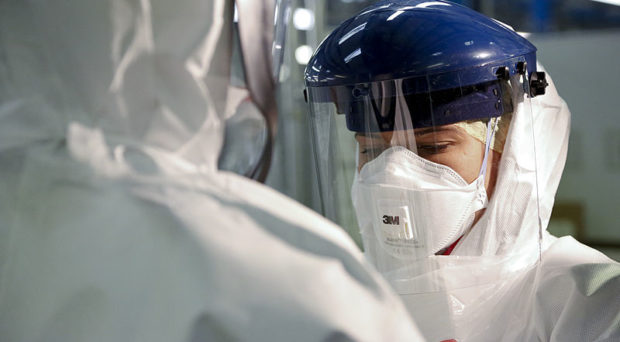
This year, personal protective equipment, or PPE, has become a household name due to the pandemic COVID-19.
So far there are over 53.7 million infected individual from COVID-19 and 1.3 million people have lost their lives in more than 217 countries and territories around the world (WHO report, 2020). This truly global nature of pandemic implies how essential PPE is in fight of humanity against COVID-19 as their appropriate use prevents infection and keep people safe especially the health care workers. PPE for the management of COVID-19 includes masks, gloves, goggles or a face shield, and respirators (N95 or FFP2 standard or equivalent).
Prior to COVID-19, the uses of PPE was rare in the field primarily restricted to outbreak situation as in Ebola or for BSL-3 or BSL-4 containment facilities where Scientists and researchers are engaged in research on pathogens or organisms such as M. tuberculosis, the causative agent of tuberculosis, which was declared a pandemic in 1991 by WHO. However, unlike COVID-19, primarily ravages poor and people in the developing countries of Asia, Africa and Latin America. With the universal rapid spread of infection of SARS-CoV-2, not surprisingly, the demand for PPEs has reached unprecedented levels as PPE requirement suddenly became a must have supply chain component at medical health centers globally.
Firstly, from infected to healthy people, everyone needs some form of PPE such as masks either to protect themselves or to prevent spread of the infection. It would be morally imperative that heath care workers and public in large have access to affordable PPE. However, the gaps in demand and supply of PPEs during COVID-19 have resulted in skyrocketing prices, threatening the most vulnerable including minorities, low income socio-ethnic groups in the developed countries, and low- and middle-income countries in general. Further exacerbating the crisis is the fact that PPE used in COVID-19 could spread infection due to the presence of virus on them and hence all PPE used should be properly disposed, mostly after one-time use. This creates a recurring cycle of demand impacting affordability.
There are at least three major challenges associated with PPE and its usage: affordability, accessibility and disposal of the used PPE.
Another very pertinent concern is the appropriate disposal of the used PPE which should be by incineration. Firstly, incineration releases the stored carbon in plastics, as well as toxic air pollutants such as dioxins, furans, mercury and polychlorinated biphenyls into the atmosphere. Secondly, the waste management and handling systems have limited capacity designed primarily based on pre-covid patterns of biomedical waste generation. Furthermore, hospitals are not equipped to handle all the patient burden and for majority of the COVID-19 patients the care is at home or isolation and quarantine facilities which often lack biosafety compliant waste collection and management mechanisms. Not surprisingly, newspaper and media reports have routinely highlighted the accumulation of PPE waste along with COVID-19 reports. Moreover, with rapidly evolving situation, civic and public health authorities have too often resort to lockdown measures which may disrupt the supply chains of essential items including PPE.
So if we summarize, there are at least three major challenges associated with PPE and its usage: affordability, accessibility and disposal of the used PPE. During the period of national lockdown in India with a rapidly evolving pandemic situation, there was a genuine concern about the disruption of supply lines, and likely scale of pandemic in a large and populous country like India. Our institute, the All India Institute of Medical Sciences (AIIMS) at New Delhi is a premier tertiary care health center which has an annual footfall of ~2-3 million patients and performs over 200,000 surgeries (AIIMS was also designated as a National nodal Center for COVID-19). The institute wanted to have the technical capability to overcome any contingency situation without impacting the well-being of patients and frontline health workers. It is in this context that we began to work on developing a safe, affordable and sustainable method of disinfection of PPE to enable their reuse as per requirement. Our method is based on vaporized hydrogen peroxide (VHP) works on breakdown of hydrogen peroxide to generate oxidative stress which in turn incapacitate and destroy the microbes . Post-disinfection, performance of the most commonly used PPE items i.e. coveralls, N-95 masks, face-shields and goggles did not change, and PPE retained their original properties, including structural integrity, at least up to 10 cycles of VHP disinfection.
We showed that even the most resilient microbial spores can be destroyed using this method making it especially useful as a general disinfectant for any contingency applications. Moreover, VHP method has negligible pollution foot-print as water vapors and oxygen are the only breakdown products. Based on the success of our procedure, we tested our findings in actual hospital settings by developing a PPE disinfection facility and successfully disinfected more than 4000 coveralls and N-95 masks used in COVID-19 care in wards and ICU settings in our hospital.
The cost of disinfection per PPE in our hands turned out to be less than Rs 10 (less than 0.10 $) making it especially useful and affordable. The whole set-up including the VHP-generator machine costs less than $7000-8000 and can be easily set-up. To assist potential users, we have also made public the protocols and standard SOPs to establish such biosafety compliant facilities to widely disseminate the knowledge to successfully establish and run any such facility. So every time a disinfection cycle is performed it reduces net consumption, net cost, increases the affordability, and reduces the pollution foot-print. Last but not the least, we have now ways and means to ensure a steady supply of PPE to our health care workers and frontline COVID warriors even if the supply lines get disrupted occasionally.
Comments